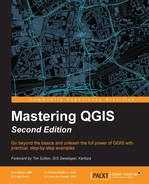 Summary
by GISP Dr. John Van Hoesen, Dr. Luigi Pirelli, GISP Dr. Richard Smith Jr., GISP Ku
Mastering QGIS - Second Edition
Summary
by GISP Dr. John Van Hoesen, Dr. Luigi Pirelli, GISP Dr. Richard Smith Jr., GISP Ku
Mastering QGIS - Second Edition
- Mastering QGIS - Second Edition
- Mastering QGIS - Second Edition
- Credits
- Foreword
- About the Authors
- About the Reviewer
- www.PacktPub.com
- Preface
- 1. A Refreshing Look at QGIS
- 2. Creating Spatial Databases
- 3. Styling Raster and Vector Data
- Choosing and managing colors
- Managing color ramps
- Styling singleband rasters
- Styling multiband rasters
- Creating a raster composite
- Raster color rendering
- Raster resampling
- Styling vectors
- Vector layer rendering
- Using diagrams to display thematic data
- Saving, loading, and setting default styles
- Summary
- 4. Preparing Vector Data for Processing
- Merging shapefiles
- Creating spatial indices
- Checking for geometry errors
- Converting vector geometries
- Creating polygon centroids
- Converting polygons to lines and lines to polygons
- Creating polygons surrounding individual points
- Extracting nodes from lines and polygons
- Simplifying and densifying features
- Converting between multipart and singlepart features
- Adding geometry columns to an attribute table
- Using basic vector geoprocessing tools
- Defining coordinate reference systems
- Viewing a statistical summary of vector layers
- Advanced field calculations
- Conditional formatting for attribute table cells
- Complex spatial and aspatial queries
- Summary
- 5. Preparing Raster Data for Processing
- 6. Advanced Data Creation and Editing
- 7. Advanced Data Visualization
- 8. The Processing Toolbox
- About the Processing Toolbox
- Performing raster analyses with GRASS
- SAGA
- Evaluating a habitat
- Calculating elevation ranges using the SAGA Raster calculator
- Clipping land use to the park boundary using Clip grid with polygon
- Querying land use for only surface water using SAGA Raster calculator
- Finding proximity to surface water using GDAL Proximity
- Querying the proximity for 1,000 meters of water using GDAL Raster calculator
- Reclassifying land use using the Reclassify grid values tool
- Combining raster layers using SAGA Raster calculator
- Evaluating a habitat
- Exploring hydrologic analyses with TauDEM
- R
- LAStools and Fusion
- Summary
- 9. Automating Workflows with the Graphical Modeler
- An introduction to the graphical modeler
- Opening the graphical modeler
- Configuring the modeler and naming a model
- Adding data inputs to your model
- Adding algorithms to your model
- Running a model
- Editing a model
- Documenting a model
- Saving, loading, and exporting models
- Executing model algorithms iteratively
- Nesting models
- Using batch processing with models
- Converting a model into a Python script
- Summary
- 10. Creating QGIS Plugins with PyQGIS and Problem Solving
- Webography – where to get API information and PyQGIS help
- The Python Console
- My second PyQGIS code snippet – looping the layer features
- Exploring iface and QGis
- Exploring a QGIS API in the Python Console
- Creating a plugin structure with Plugin Builder
- A simple plugin example
- Setting up a debugging environment
- Debugging session example
- Summary
- 11. PyQGIS Scripting
- Where to learn Python basics
- How to load layers
- Vector structure
- Iterating over features
- Editing features
- Running Processing Toolbox algorithms
- Running an external algorithm or command
- Interacting with the map canvas
- Summary
This chapter offered you a simplified way to interact with QGIS, and it is more oriented toward a GIS analyst than a GIS programmer or a computer scientist. The chapter is also oriented to GIS companies that are interested in reusing code that has already been developed but was probably developed for GIS platforms that are not free.
This chapter gives basic knowledge about how to interact with QGIS using the PyQGIS programming language.
We saw how to programmatically load different kinds of layers, from raster to vector. We also explained vectors and how to manage different kinds of vector resources, from filesystems to remote database connections. We also explored the vector structure in more detail, and you learned how to browse and edit its records. Different kinds of editing workflows were proposed in the chapter so that you can interact with the QGIS framework in a better manner.
You learned how to launch Processing Toolbox algorithms and user-developed Processing Toolbox scripts to enhance QGIS with new functionalities. You also learned how to launch external commands or scripts to offer a way to integrate already developed code, and thereby reduce developing and testing costs.
Lastly, we explored the QGIS map canvas and how to interact with that using Map Tools. We obtained canvas coordinates and created new Map Tools to draw canvas objects. This will give you the basic skills needed to create new plugins that interact with layers displayed in the QGIS canvas.
-
No Comment